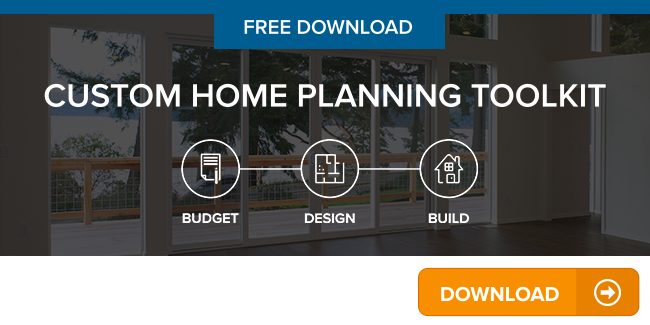Make a List of Your Deal Breakers There is an old adage that real estate is all about location, location, location. But often that means compromise, compromise, compromise. The existing home in the perfect location may have a less-than-perfect kitchen. Or the home with the perfect kitchen may have a what-were-they-thinking master suite. Before you search news homes in person or even online, make a list of every must have for your new home. This might include:
- Open concept kitchen with pantry
- First floor master suite with walk-in shower
- Three-car garage
- Walk-in closets in the secondary bedrooms
- Private location with views
Next, Expand the Possibilities
When you shop for existing real estate you are limited by what’s available in the market at any given time. When you build a custom home you have none of these limitations. Instead, you are limited only by your own imagination. Once you have a list of the must-haves (and have nots) for your new home, it’s time to expand your idea of what’s possible. Create an Ideabook for free on Houzz and save pictures of features and design styles that you like. You can also create boards on Pinterest for every room of your home. Think beyond traditional home features to create a home that’s truly unique. Here some fun ideas for inspiration:- His and her home offices
- A music room
- Technology hub
- A separate guest cottage on the property
- Dual master suite
- An en suite bath and walk-in closet for secondary bedrooms
- Private entry apartment
- A great room with a stunning fireplace focal point
Create a Smart Shopping Strategy
Once you’ve compiled your deal breakers and your wish list it’s time to develop a strategy for shopping for a new home. Organize your wants and needs into a checklist that you can easily reference on your iPad or smartphone when you look at homes online or in person. Here are a few smart strategies:- Use a free tool such as Evernote to organize needs, wants, and create checklists for each home you visit
- When you attend Open Houses, take photos and keep photos organized by home (this can also be done in Evernote). This makes it easier to review and compare each home later
- The internet is a great tool to narrow down your search but it’s important to see homes in person to experience the light, views, room size, and details that reveal the quality of construction
- Create a simple comparison chart for an at-a-glance snapshot of how well existing homes match your lists of needs and wants within your budget
Now, Compare the Cost of Custom
Once you have an estimate of your “all-in” cost (price, repairs, renovations, updates, additional costs of ownership), schedule a consultation with a custom home builder. Bring your list of needs and wants and your comparison chart. A custom home builder will be able to estimate the cost of designing and building a custom home that is exactly what you want. When you interview home builders to determine if building a new home is more cost effective than buying an existing home, consider several factors:- Included features: How much will your new home cost including all of the features you want? (A brand new home with the features you want may cost more upfront but replacing, repairing, and renovating an older home to get the design you want may cost more in the long run.
- Time and Budget: Does the builder have a proven track record of delivering homes on time and on budget? (Cost overruns are the most common cause of new homes going over budget. Fortunately they are completely avoidable when you choose a builder with an effective process.)
- “Kinda” Custom: Does your builder offer preset plans with a few options or are they a true design build firm? (Building or buying a home with rooms and features you don’t need or won’t use is more costly that intelligent design that maximizes every square foot based on your lifestyle.)
Make an Informed Decision
Now that you have the facts you can make the most confident decision about your next home. As an award-winning design build firm with more than 25 years of experience in Western Washington, we’ve helped many customers compare the true costs of custom versus resale. Many of our customers who originally thought building a custom home would be too expensive or too time consuming have found that designing the exact home – in the exact location – they wanted gave them more freedom over their budget. What’s right for you? Schedule a free Project Analysis with our team and tell us about your vision for your new home. Tell us about your wants and needs for your new home and we can help you determine if building custom is the right fit for your vision, your timeframe, and your budget. Are you located outside the area but interested in building in Western Washington? Contact us to schedule a free Project Analysis by Skype. Estes Builders is an award-winning design build firm that specializes in custom homes in Western Washington. We have earned more than 130 customer testimonials and a reputation as Western Washington’s most trusted custom home builder. We build custom homes in Sequim, Port Angeles, Port Townsend, Port Ludlow, Bainbridge Island, Kingston, Silverdale, Port Orchard and surrounding areas. Contact us for a FREE Project Analysis to discuss your project.]]>
Estes Builders is an award-winning design build firm that specializes in custom homes in Western Washington. We have earned more than 130 customer testimonials and a reputation as Western Washington’s most trusted custom home builder. We build custom homes in Sequim, Port Angeles, Port Townsend, Port Ludlow, Bainbridge Island, Kingston, Silverdale, Port Orchard and surrounding areas. Contact us for a FREE Project Analysis to discuss your project.]]>

